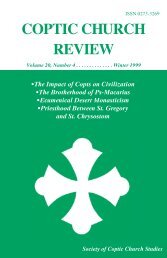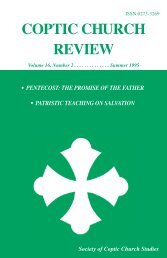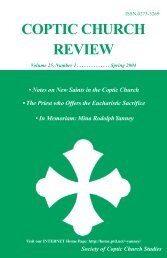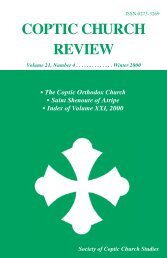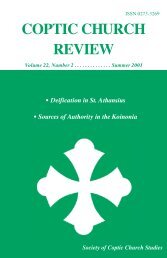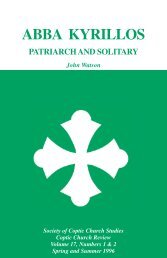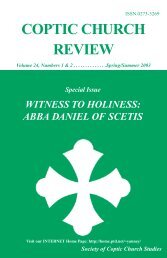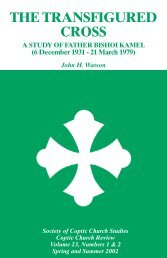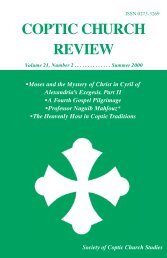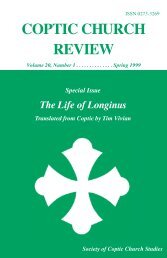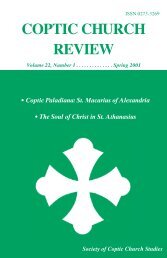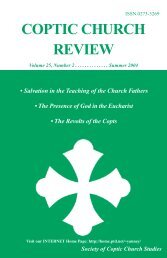Home_files/2000 Fall.Vol22.#3.pdf - Coptic Church Review
Home_files/2000 Fall.Vol22.#3.pdf - Coptic Church Review
Home_files/2000 Fall.Vol22.#3.pdf - Coptic Church Review
- No tags were found...
Create successful ePaper yourself
Turn your PDF publications into a flip-book with our unique Google optimized e-Paper software.
COPTIC PALLADIANA III: THE LIFE OF MACARIUS OF EGYPT 87between Macarius the Great and Antony (see AP Macarius 4 and 26), it isnot surprising that the Macarius who buried Antony (according to Jeromeand Palladius) became Macarius the Great. Since, however, Palladius clearlystates (LH 21.1) that Antony’s Macarius still dwelt in Pispir, Antony’souter mountain, he can not have also believed that Macarius the Greatburied Antony. It is clear that later monastic tradition, in its desire to moreclosely associate two of the great founders of monasticism (an association,as noted above, that does have historical basis) conflated Macarius of Pispirand Macarius of Scetis.The chronology is close, but the mistaken statement that Macarius theGreat buried Antony is wrong. Could the latter be an editorial (or scribal)gloss? This seems possible because of what the author goes on to say: thathe learned about Macarius directly from the saint’s disciples—and fromEvagrius. In the Virtues of Macarius, Evagrius “the sage” is the interlocutorof Macarius most often mentioned. That such a statement about Evagriuscould come from Palladius is not only plausible but likely. In fact, theauthor of the <strong>Coptic</strong> Life is careful to indicate his sources (pars. 4, 6, 10, 12;all but the last do not have parallels in the LH). The fact that the authorgives Evagrius as a prominent source, and that this fact does not appear inthe Lausiac History, makes it seem credible that this source was edited outby a later editor of the History. (On the expunging of Evagrius from themonastic record, see the General Introduction.) 24 If, therefore, the <strong>Coptic</strong>Life represents an early draft by Palladius of what would become theLausiac History, Palladius himself could have deleted some of it later. Or,if the <strong>Coptic</strong> Life represents an unexpurgated version of the LausiacHistory, the extra material found in the <strong>Coptic</strong> Life could have been effacedin the Greek tradition by a redactor. In any case, there is at least a possibilitythat some of the extra material in the <strong>Coptic</strong> Life is Palladian. I wouldsuggest that the statements about Evagrius do go back to Palladius, and thatsome of the other <strong>Coptic</strong> material was added during later transmission byscribes and editors.Undoubtedly the most important of this extra material is par. 6, on themonk led astray by an evil spirit that “wrapped him in the erroneous doctrineof heresies that are named after Hieracas.” 25 The account of the followerof Hieracas preserved in Lausiac History 17.11 is obviously an epitome,combined (badly) with the story of a demoniac. The <strong>Coptic</strong> Life preserveswhat must have been the original, longer, version (par. 5) and followsit with the story of the demoniac (par. 6). We know from other sources24 C.P. Bammel, “Problems of the Historia Monachorum,” Journal of Theological Studies, NS, 47.1(April 1996), 92-104, esp. 99-101, has shown that the Historia Monachorum, like the LH, was subjectedto anti-Origenistic and -Evagrian editing.25 The monk is later called “Hieracas” in the story, but this is a mistake.




